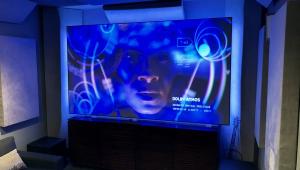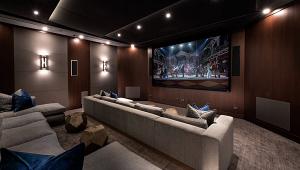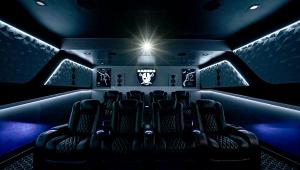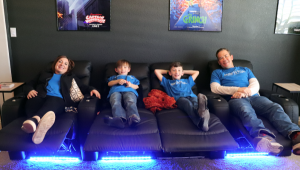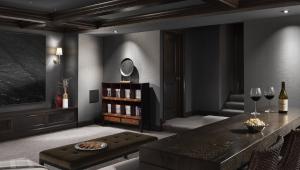What's Missing From this Picture?

Integrating and controlling the villa's electrical cornucopia, while respecting the architecture, was a real challenge. Sound Solutions accomplished this by strategically positioning 17 wall-mounted color touchpanels, along with an assortment of 10-inch Wi-Fi tablets and 12-inch tabletop touchpanels. The installers programmed all of these gadgets to intuitively control the home's central and multiple music and video systems, the pan/tilt/zoom CCTV cameras, thermostats, the pool/spa/fountain, vehicle and pedestrian gate access, security, the weather station, and 14 motorized shades to protect antiques and carpets from sunlight. Due to the numerous subsystems, the installers designed all touchpanel menus and page flips for ease of use. For obvious reasons, the team had to design and program the security, access, and CCTV camera elements for instant, intuitive operation. In another example, they programmed the weather station's temperature, barometer, dew point, and humidity readouts for easy access on the touchpanels. Says David Epstein, president of Sound Solutions, "The operative rule for the control-system programming is that it must always be houseguest friendly. If a non-tech-savvy family member cannot intuitively operate any of the subsystems without training, we consider ourselves as having failed." And all of this is in an environment that harkens back to a time before electricity was even identified.

All traces of technology either completely disappeared or were disguised, relying heavily on the arts of distraction and camouflage. In areas where the house needed touchpanels for optimal coverage, the installers mounted them near other architectural elements, like hand-painted tile or busts on pedestals. A fanatic focus on color matching included faux-painting the touchpanels, as in the wood-paneled library. In another example, due to aesthetic considerations, the DSS antenna and weather station were pole-mounted 50 yards away on the hillside orchard. As the high-tech look of the PTZ dome cameras stand in sharp contrast to the organic architecture, the installers discretely mounted them into exterior soffits so as to be barely noticeable. No element of technology interferes with the authentic look of the home.
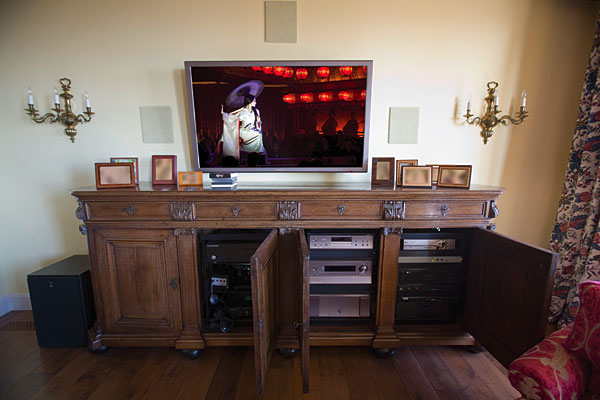
A striking example of hidden technology is the custom-carved, period-style grille work that disguises a combination of heating/cooling ducts, speakers, and subwoofers, providing isolation while remaining rattle free. Accomplishing this required close cooperation among the A/V, HVAC, design, and cabinet contractors. Most awe-inspiring is the painstaking modification of the 17th-century Belgian cabinet in the club room in which installers rack-mounted the A/V, control, and gaming components. Hidden rollers facilitate movement of the massive, solid-oak, 10-foot-long cabinet for rear access. As the story goes, this credenza belonged to a Belgian ship's captain whose ghost still haunts it. Occasionally, the piece will creak, an indication that the ghost either approves of, or hates, whatever movie is playing. A wall cavity behind the cabinet accommodates the oversized Integra Research components, thus minimizing the cabinet's intrusion into the room. Apparently, amplifiers were much smaller in the 1700s.

Upstairs, installers gave great care to integrate the plasma lift cabinet in the master bedroom. It was crucial to match the centuries-old bed and upholstery elements without impeding the lift's mechanics or the plasma's performance.
From the outset of the design phase, it became clear that traditional thinking would not suffice. There were far too many obstacles to apply standard solutions. So, for example, the design team developed the concept of a virtual megasystem, comprised of the many A/V sources throughout the home—Internet, audio servers (including the owner's home-built RAID-based system) satellite music, and four local A/V systems—each distributed through all 19 zones and five subzones. They accomplished this via a network of audio and video ties among the numerous sources and systems. The outdoor speakers are independently zoned for the pool/spa area, gazebo, cabana, and lawn area. The owners can access and play the central TiVos from all TVs in the home. The residents can personalize their recording selections and can share them with each other. The owners are not big film buffs, and, although there is no central video server, they agreed with the wisdom of preparing the home for one in the future. They will most likely knock one together some weekend.

Work @ Home
As successful multimedia and game developers, this young couple incorporates lots of advanced technologies into their active lifestyle. Many elements typically found in commercial environments were applied in this residence, raising the need to redefine the meanings of workplace and home. The owner has designated the Music Studio as an actual laboratory for building audio/video servers which required special infrastructure and control system design by Sound Solutions. The room includes Karaoke and a local audio/video system. Video games are developed and tested in the Study, requiring a combination of specialized multi-format equipment, CAT6 wiring, Wi-Fi, and Sound Solutions programming to maximize functionality and bandwidth for computer/Internet usage.
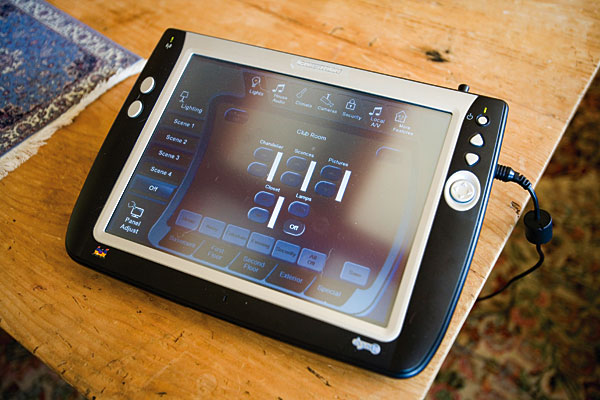
Lighting Dimming Everywhere
Did we mention lighting dimming? The customized Crestron dimming system includes fifty-nine keypads and over two hundred circuits. Global house settings allow the immediate recall of preferred lighting settings by room or for the entire house. The owners can easily set and save their own lighting levels per room as the mood suits. A clever Sound Solutions programming touch, "Occupied/Unoccupied" modes, provides for control of lights "On/Off" for remote rooms, making the tedious 'house patrol hike' obsolete. As the owner states: "The system is powerful and convenient, and saves huge amounts of time everyday. Running around turning on/off lights in a large house could be very tedious!"

A glance at the touchpanel shows the home's room layout. A light bulb icon identifies any lights on. Lights can be turned off on the touchpanel while leaving selected lights on, a courteous touch for houseguests or a midnight-snacking, insomniac husband.

Safe and Secure
To our knowledge, security systems did not exist in the 1700's with the possible exception of watch-geese to warn of approaching Redcoats. However, this is now, not then. For security, all twelve of the cameras can be viewed on all TV's as well as the touchpanels. Any combination can be selected simultaneously. The vantage point from the property is dramatic and the PTZ (pan-tilt-zoom) cameras deliver breathtaking ocean and mountain views past the immediate neighborhood to surprising distances, with close-ups in high detail. The owner has declared this CCTV system his favorite new toy, which, considering what he does for a living, is saying a lot. He is quite taken with the entire security system and operates the cameras frequently by a combination of button presses and finger motion across the touchpanels, adjusting the cameras' frame rate and accessing recorded activity on the Digital Video Recorder. Open/Closed window status and a fire icon is easily viewed on the touchpanels, as is the emulation of the security alarm panel itself, programmed into the control system. Any security event which triggers a text message can be immediately read on the control system's touchpanels, which are located in numerous places throughout the home. The Redcoats don't have a prayer of getting within a hundred miles.

Command Central: The Club Room
Video gaming is both owners' careers and passions. One would hardly realize the Club Room's warm and cozy atmosphere houses a whopper of an A/V system that also functions as an R&D game lab and test facility. Playstation2, X-Box, Game Cube, and Alienware platforms are selected through the Integra Research preamp and Crestron Wi-Fi tablet. The owners can switch from among video games, movies, and other sources at will. It's not all work, work, work, however. The experience of playing video games through such a high-performance system provides the ultimate test for, and the enjoyment of their own creations. This multi-purpose Club Room is an example of a high-SPL system integrated into a central living space, with heavy emphasis on aesthetics. The system includes a 61" Marantz plasma monitor and M&K THX surround speaker system with two dual-12" 350- watt subwoofers. Sources include HD satellite/TiVo, Internet radio, and an Integra Research DVD player with scaler. The Integra Research preamp is equipped with optional input cards, including HDMI and 5-input upconversion. Audio ties to the central music system access two music servers (including the owner's home-built RAID-based system), satellite music, and FM tuner. The rear "wall" of the room is a heavy tapestry-type curtain, which opens to the kitchen. The wall of windows includes integrated, motorized shades.
Since this home took several years to complete, futureproofing was a concern. This was a primary consideration during the planning stage. Also, the final selection of components was coordinated with the move-in date so as to take advantage of the most current products and technologies.
Says the home's owner: "Overall, I think the house is probably one of the most sophisticated and clean jobs of system integrations available anywhere and it provides 21st century state of the art technology discretely hidden in a very authentic 18th century Italian environment!" There are still a few upgrades to be done. The Sound Solutions' programming staff has not completed the button press which takes these techies back to 1750, but they're working on it.
How It Works for You
Future-Proof It. If you are investing a significant amount of money on your system, future-proofing it becomes a big concern. If possible, put off the final selection of components until the end, so that you can take advantage of the most current technologies.
Hide It. When technology presents a jarring effect in a room, hiding it becomes a solution. Talk with your installer about hiding your gear. You can house gear in closets, a screen can drop down from the ceiling, a plasma can rise out of a lift at the end of the bed, and you can even paint speakers to blend in.
Control It. Wholehouse audio and video dictates the need for more than just a simple remote to turn a home theater on and off. Invest in a sturdy and intuitive programmable control system, such as those from Crestron, AMX, and Control4.
